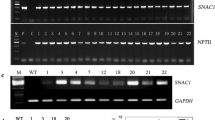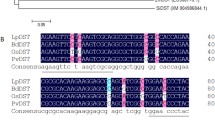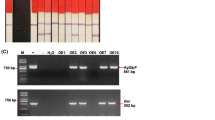Abstract
As salinity is a major threat to sustainable agriculture worldwide, cultivation of salt-tolerant crops becomes increasingly important. IrrE acts as a global regulator and a general switch for stress resistance in Deinococcus radiodurans. In this study, to determine whether the irrE gene can improve the salt tolerance of Brassica napus, we introduced the irrE gene into B. napus by the Agrobacterium tumefaciens-mediated transformation method. Forty-two independent transgenic plants were regenerated. Polymerase chain reaction (PCR) analyses confirmed that the irrE gene had integrated into the plant genome. Northern as well as Western blot analyses revealed that the transgene was expressed at various levels in transgenic plants. Analysis for the T1 progenies derived from four independent transformants showed that irrE had enhanced the salt tolerance of T1 in the presence of 350 mM NaCl. Furthermore, under salt stress, transgenic plants accumulated more compatible solutes (proline) and a lower level of malondialdehyde (MDA), and they had higher activities of catalase (CAT), peroxidase (POD) and superoxide dismutase (SOD). However, agronomic traits were not affected by irrE gene overexpression in the transgenic B. napus plants. This study indicates that the irrE gene can improve the salt tolerance of B. napus and represents a promising candidate for the development of crops with enhanced salt tolerance by genetic engineering.





Similar content being viewed by others
References
Ahmad ET (2008) High-voltage pulsed galvanic stimulation: effect of treatment duration on healing of chronic pressure ulcers. Ann Burns Fire Disasters 21:124–128
Ahmad N, Zanariah Y, Balan S (2008) Fentanyl pre-treatment alleviates pain during injection of propofol-lipuro premixed with lignocaine. Med J Malays 63:431–433
Ahmad A, Khan A, Khan LA, Manzoor N (2010a) In vitro synergy of eugenol and methyleugenol with fluconazole against clinical Candida isolates. J Med Microbiol 59:1178–1184
Ahmad MSA, Ashraf M, Ali Q (2010b) Soil salinity as a selection pressure is a key determinant for the evolution of salt tolerance in Blue Panicgrass (Panicum antidotale Retz.). Flora Morphol Distrib Funct Ecol Plants 205:37–45
Ahmad P, Ashraf M, Younis M et al (2012) Role of transgenic plants in agriculture and biopharming. Biotechnol Adv 30:524–540
Anderson AW, Nordon HC, Cain RF et al (1956) Studies on a radio-resistant Micrococcus. I. Isolation, cultural characteristics, and resistance to gamma radiation. Food Technol 10:575–578
Apse MP, Aharon GS, Snedden WA, Blumwald E (1999) Salt tolerance conferred by overexpression of a vacuolar Na+/H+ antiport in Arabidopsis. Science 285:1256–1258
Ashraf M, Fatima H (1995) Responses of salt-tolerant and salt-sensitive lines of safflower (Carthamus tinctorius L.) to salt stress. Acta Physiol Plant 1:61–70
Ashraf M, Foolad MR (2007) Roles of glycine betaine and proline in improving plant abiotic stress resistance. Environ Exp Bot 2:206–216
Bartels D, Sunkar R (2005) Drought and salt tolerance in plants. Crit Rev Plant Sci 24:23–58
Beauchamp C, Fridovich I (1971) Superoxide dismutase: improved assays and an assay applicable to acrylamide gels. Anal Biochem 44:276–287
Beers RF, Sizer IW (1952) A spectrophotometric method for measuring the breakdown of hydrogen peroxide by catalase. J Biol Chem 195:133–140
Dai Q, Chen C, Feng B et al (2009) Effects of different NaCl concentration on the antioxidant enzymes in oilseed rape (Brassica napus L.) seedlings. Plant Growth Regul 59:273–278
Earl AM, Mohundro MM, Mian IS et al (2002) The IrrE protein of Deinococcus radiodurans R1 is a novel regulator of recA expression. J Bacteriol 184:6216–6224
Flowers TJ, Yeo AR (1995) Breeding for salinity resistance in crop plants: where next? Funct Plant Biol 22:875–884
Gao G, Tian B, Liu L et al (2003) Expression of Deinococcus radiodurans PprI enhances the radioresistance of Escherichia coli. DNA Repair (Amst) 2:1419–1427
Geebelen W, Vangronsveld J, Adriano DC et al (2002) Amendment-induced immobilization of lead in a lead-spiked soil: evidence from phytotoxicity studies. Water Air Soil Pollut 140:261–277
Gengmao Z, Quanmei S, Yu H et al (2014) The physiological and biochemical responses of a medicinal plant (Salvia miltiorrhiza L.) to stress caused by various concentrations of NaCl. PLoS ONE 9:e89624
Grumet R, Wolfenbarger L, Ferenczi A (2011) Future possible genetically engineered crops and traits and potential environmental concerns. Environmental Safety of Genetically Engineered Crops, pp 47–57
Guttikonda SK, Valliyodan B, Neelakandan AK et al (2014) Overexpression of AtDREB1D transcription factor improves drought tolerance in soybean. Mol Biol Rep 41:7995–8008
Hanafy MS, El-Banna A, Schumacher HM et al (2013) Enhanced tolerance to drought and salt stresses in transgenic faba bean (Vicia faba L.) plants by heterologous expression of the PR10a gene from potato. Plant Cell Rep 32:663–674
Hassen A, Maher S, Cherif H et al (2014) Effect of salt stress (NaCl) on germination and early seedling parameters of three pepper cultivars (Capsicum annuum L.). J Stress Physiol Biochem 10:14
He Z, Duan Z, Liang W et al (2006) Mannose selection system used for cucumber transformation. Plant Cell Rep 25:953–958
Heath LP, Packer L (1968) Photoperoxidation in isolated chloroplasts I: kinetics and stoichiometry of fatty acid peroxidation. Arch Biochem Biophys 125:189–198
Hood EE, Gelvin SB, Melchers LS, Hoekema A (1993) New Agrobacterium helper plasmids for gene transfer to plants. Transgenic Res 2:208–218
Hua Y, Narumi I, Gao G et al (2003) PprI: a general switch responsible for extreme radioresistance of Deinococcus radiodurans. Biochem Biophys Res Commun 306:354–360
Joersbo M, Donaldson I, Kreiberg J et al (1998) Analysis of mannose selection used for transformation of sugar beet. Mol Breed 4:111–117
Krämer H, Cagan RL, Zipursky SL (1991) Interaction of bride of sevenless membrane-bound ligand and the sevenless tyrosine-kinase receptor. Nature 352:207–212
Lucca P, Ye X, Potrykus I (2001) Effective selection and regeneration of transgenic rice plants with mannose as selective agent. Mol Breed 7:43–49
Ma R, Zhang Y, Hong H et al (2011) Improved osmotic tolerance and ethanol production of ethanologenic Escherichia coli by IrrE, a global regulator of radiation-resistance of Deinococcus radiodurans. Curr Microbiol 62:659–664
Makarova KS, Omelchenko MV, Gaidamakova EK, Matrosova VYVA (2007) Deinococcus geotherma lis: the pool of extreme radiation resistance genes. PLoS ONE 2:e955
Munns R, Tester M (2008) Mechanisms of salinity tolerance. Annu Rev Plant Biol 59:651–681
Negrotto D, Jolley M, Beer S et al (2000) The use of phosphomannose-isomerase as a selectable marker to recover transgenic maize plants (Zea mays L.) via Agrobacterium transformation. Plant Cell Rep 19:798–803
Niu C, Wei W (2012) Wheat WRKY genes TaWRKY2 and TaWRKY19 regulate abiotic stress tolerance in transgenic Arabidopsis plants. Plant Cell Environ 35:1156–1170
Omran RG (1980) Peroxide levels and activities of catalase, peroxidase and indoleacetic acid oxidase during and after chilling cucumber seedlings. Plant Physiol 65:407–498
Pan J, Wang J, Zhou Z et al (2009) IrrE, a global regulator of extreme radiation resistance in Deinococcus radiodurans, enhances salt tolerance in Escherichia coli and Brassica napus. PLoS ONE 4:e4422
Pellegrineschi A, Reynolds M, Pacheco M et al (2004) Stress-induced expression in wheat of the Arabidopsis thaliana DREB1A gene delays water stress symptoms under greenhouse conditions. Genome 47:493–500
Rama Devi S, Prasad MN (1998) Copper toxicity in Ceratophyllum demersum L. (Coontail), a free floating macrophyte: response of antioxidant enzymes and antioxidants. Plant Sci 138:157–165
Randall SK, Sze H (1986) Properties of the partially purified tonoplast H+-pumping ATPase from oat roots. J Biol Chem 261:1364–1371
Solleti SK, Bakshi S, Sahoo L (2008) Additional virulence genes in conjunction with efficient selection scheme, and compatible culture regime enhance recovery of stable transgenic plants in cowpea via Agrobacterium tumefaciens-mediated transformation. J Biotechnol 135:97–104
Surender RP, Jogeswar G, Rasineni GK et al (2015) Proline over-accumulation alleviates salt stress and protects photosynthetic and antioxidant enzyme activities in transgenic sorghum [Sorghum bicolor (L.) Moench]. Plant Physiol Biochem 94:104–113
Thomas PS (1980) Hybridization of denatured RNA and small DNA fragments transferred to nitrocellulose. Proc Natl Acad Sci USA 77:5201–5205
Wang AS, Evans RA, Altendorf PR et al (2000) A mannose selection system for production of fertile transgenic maize plants from protoplasts. Plant Cell Rep 19:654–660
Wang J, Zuo KJ, Wu W et al (2004) Expression of a novel antiporter gene from Brassica napus resulted in enhanced salt tolerance in transgenic tobacco plants. Biol Plant 48:509–515
Wang J, Fan Z, Liu Z et al (2011) Thylakoid-bound ascorbate peroxidase increases resistance to salt stress and drought in Brassica napus. Afr J Biotechnol 10:8039–8045
Wright M, Dawson J, Dunder E et al (2001) Efficient biolistic transformation of maize (Zea mays L.) and wheat (Triticum aestivum L.) using the phosphomannose isomerase gene, pmi, as the selectable marker. Plant Cell Rep 20:429–436
Wu J, Wu LT, Liu ZB et al (2009) A plant defense gene from Orychophragmus violaceus can improve Brassica napus' resistance to Sclerotinia sclerotiorum. Afr J Biotechnol 8:6101–6109
Xu G, Cui Y, Wang M et al (2014) OsMsr9, a novel putative rice F-box containing protein, confers enhanced salt tolerance in transgenic rice and Arabidopsis. Mol Breed 34:1055–1064
Zhang M, Zhuo X, Wang J et al (2015) Phosphomannose isomerase affects the key enzymes of glycolysis and sucrose metabolism in transgenic sugarcane overexpressing the manA gene. Mol Breed 35:100–109
Zhu JK (2001) Plant salt tolerance. Trends Plant Sci 2:66–71
Zhao P, Zhou Z, Zhang W et al (2015) Global transcriptional analysis of Escherichia coli expressing IrrE, a regulator from Deinococcus radiodurans, in response to NaCl shock. Mol BioSyst 11:1165–1171
Acknowledgments
This work was funded by the 973 Project in China (2013CB733903) and China Transgenic Program (2014ZX0801201B).
Author information
Authors and Affiliations
Corresponding authors
Additional information
Jin Wang, Cui Guo, and Qilin Dai have contributed equally to this paper.
Electronic supplementary material
Below is the link to the electronic supplementary material.

11032_2016_486_MOESM1_ESM.jpg
Fig. S1 Generating transgenic irrE oilseed rape plants. A Schematic diagram of the irrE expression cassette in the binary vector pBI121. The transgene was inserted between the CaMV35S promoter (35S) and NOS terminator (NOST); the NPTII marker is flanked by the NOS promoter (NOSP) and terminator (NOS-Ter). B–C The formation of the callus during transformation. D The screening of the explants and regenerating of transgenic B. napus plants. E Transferring the regenerated plants into soil (JPEG 11002 kb)
Rights and permissions
About this article
Cite this article
Wang, J., Guo, C., Dai, Q. et al. Salt tolerance conferred by expression of a global regulator IrrE from Deinococcus radiodurans in oilseed rape. Mol Breeding 36, 88 (2016). https://doi.org/10.1007/s11032-016-0486-7
Received:
Accepted:
Published:
DOI: https://doi.org/10.1007/s11032-016-0486-7




